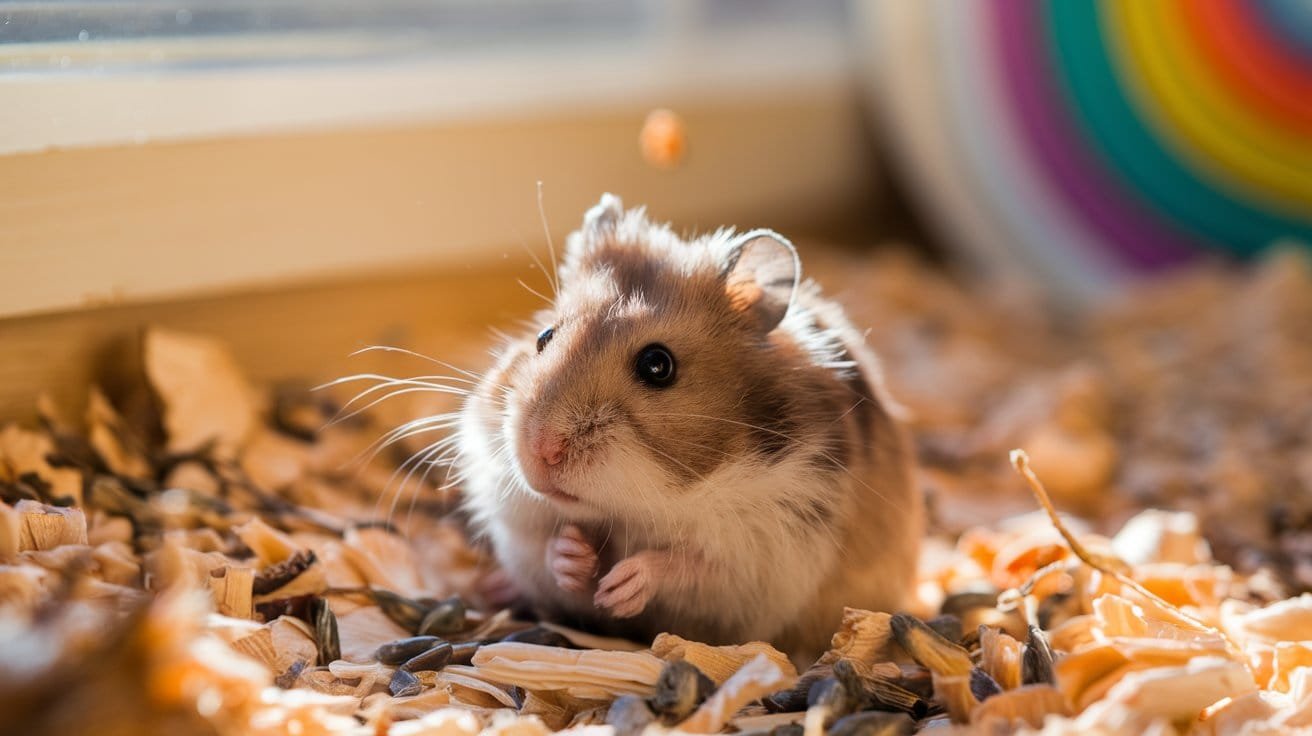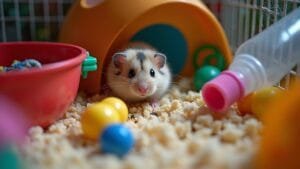No, hamsters don’t have periods like humans do. Instead, female hamsters experience an estrous cycle every four days, all year round! This cycle is influenced by light and dark conditions. You might notice changes in their vaginal discharge, which goes from clear to thick white when they’re ready to mate. They can start cycling as early as 35 days old. If they become pregnant, the cycle stops until they wean their pups. So, while they don’t ‘bleed’ every month, they definitely have their own unique reproductive system! Excited to find out more hamster facts? There’s plenty to explore!
Understanding the Estrous Cycle
Understanding the estrous cycle in hamsters is crucial if you’re considering breeding these small pets. Did you know that a female hamster goes through her cycle every four days? Yep! This happens year-round, which means you can plan your breeding right.
Now, this cycle doesn’t just happen randomly. It’s linked to the light and dark cycles of the day, influencing when your hamster feels most active and ready to mate. During the estrous cycle, you’ll notice some changes in vaginal discharge, which can tell you what stage she’s in. Additionally, it’s important to note that females may enter estrus as early as 35 days old, making it essential to monitor them closely as they mature.
Typically, the best time for mating is on the third evening of the cycle. Just keep an eye out for that discharge! If she doesn’t have any discharge on days five or nine after mating, there’s a strong chance she’s pregnant.
Pregnancy will interrupt that cycle, so you won’t see it repeat until after the pups are weaned. Plus, be aware that pseudopregnancy can happen too!
Signs of Estrous Behavior
Recognizing the signs of estrous behavior in hamsters can be key to successful breeding. So, what should you look for? One major sign is vaginal discharge. You might notice it changing from clear to a thicker, white consistency when your female hamster is in estrus.
Another indicator is the female’s posture. When she’s receptive, she may display lordosis, a position that seems to say, “Hey, I’m ready!”
Keep an eye on her marking behaviors, too. Females will often engage in vaginal marking to catch a male’s attention.
But it’s not just about what they’re doing; their behavior speaks volumes. Receptive females might run, then freeze—an invitation for males. You should also watch how they interact; females can be aggressive if they’re not in estrus. Female attractivity and proceptivity fluctuate throughout the estrous cycle, so it’s essential to monitor these signs closely.
Lighting and temperature play a role as well. Did you know that about 12 hours of light a day can trigger breeding all year round?
Breeding and Reproduction
Once you’ve identified the signs of estrous behavior in female hamsters, you’re ready to move on to breeding and reproduction. The first step is knowing when your hamsters are mature enough. Hamsters typically reach sexual maturity between 4 and 8 weeks, but waiting until they’re about 6 months old is smarter to avoid complications and cannibalism. Breeding at an optimal age is crucial for a successful pairing and to mitigate risks.
So how do you mate them? It’s best to use a pair—1 male and 1 female. You should introduce them in the evening when they’re more active. Some breeders like to use neutral zones to let them get used to each other’s scents first.
Here’s a quick reference table to keep track of important breeding details:
| Factor | Details |
|---|---|
| Age of Maturity | 4-8 weeks (best after 6 months) |
| Mating Method | 1 male + 1 female |
| Estrous Cycle | Every 4 days (10-12 hours) |
| Gestation Period | 16-22 days |
| Litter Size | 3-12 (depending on species) |
Pregnancy and Birth Process
The pregnancy and birth process in hamsters is both fascinating and intricate. When you notice a significant weight gain in your hamster, especially in her abdomen, it’s a strong indicator she might be pregnant. Pregnant hamsters often start building nests, shredding bedding materials like they’re preparing for a cozy home. You might even see her nipples become more visible.
Expect the gestation period to last anywhere from 16 to 22 days, depending on the type of hamster. Typically, Syrian hamsters have a shorter span of around 16 to 17 days. Babies usually arrive during the day, thanks to their natural circadian rhythm that aligns with light and dark cycles. Interestingly, the mating time can influence the timing of births, with evening matings leading to earlier arrivals.
During the birth process, your hamster will have live births, and she’ll clean each pup right after it’s born—adorable, isn’t it? To help her out, make sure her environment is quiet and private. You can provide extra nesting materials, and it might be wise to keep the male away for the time being.
For the next few days, stay hands-off with the newborns—let her do the caring! This simple approach helps keep every hammy safe and sound.
Health Considerations for Breeding
Breeding hamsters can be rewarding, but it also comes with responsibilities that go beyond just the birth process. To guarantee a successful breeding experience, you need to pay attention to a few key areas:
- Genetic Health: Understand genetics to avoid passing on health issues. Cysts can affect fertility, so aim to produce healthy offspring.
- Cage Environment: Keep the cage peaceful and spacious. Overcrowding can lead to stress, which may cause mothers to abandon their babies.
- Dietary Needs: Prioritize a high-protein diet for your pregnant or nursing hamsters. Fresh fruits and veggies are a great supplement. It’s essential to ensure their diet supports.
Don’t forget to schedule regular vet visits. A good vet can spot health issues early, guaranteeing that both the mother and her babies stay healthy.
Your hamster’s environment should be clean, with sufficient nesting material and ventilation to reduce stress and disease risk.
And remember, financial readiness is important; emergencies can arise, and treatment costs can add up.
Common Misconceptions About Hamsters
Many pet owners hold misconceptions about hamsters that can lead to misunderstandings about their care and behavior. For instance, you might think hamsters have menstrual periods like humans, but that’s not true! They have estrous cycles, lasting about four days, without any bleeding. In fact, hamsters experience heat cycles every 4-5 days.
Here’s a quick look at some common myths:
| Misconception | Reality |
|---|---|
| Hamsters have menstrual periods | They have estrous cycles, no bleeding |
| Young hamsters can breed healthily | They should wait until 10 weeks old |
| Hamsters are social animals | Syrian hamsters are solitary and territorial |
When it comes to breeding, if your female hamster is too young, complications can arise. Also, their pregnancies are short—about 16 days! And don’t forget, Syrian hamsters should be kept alone to avoid fights.
Understanding these facts helps you give your furry friend the best environment possible. So, next time you hear an old wives’ tale about hamsters, you’ll be ready to set the record straight!




